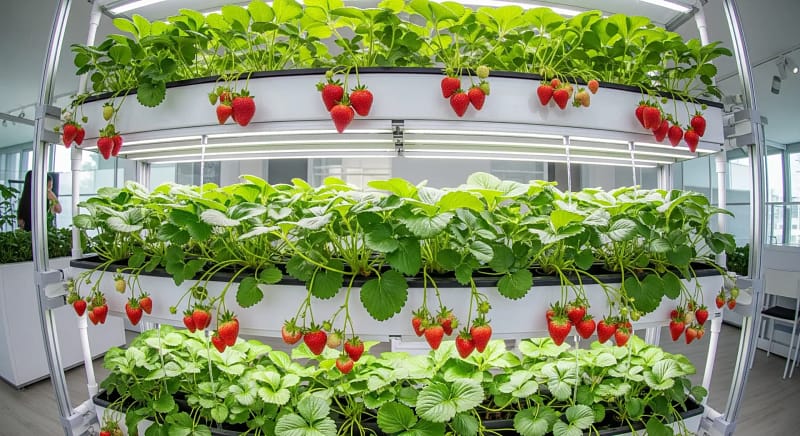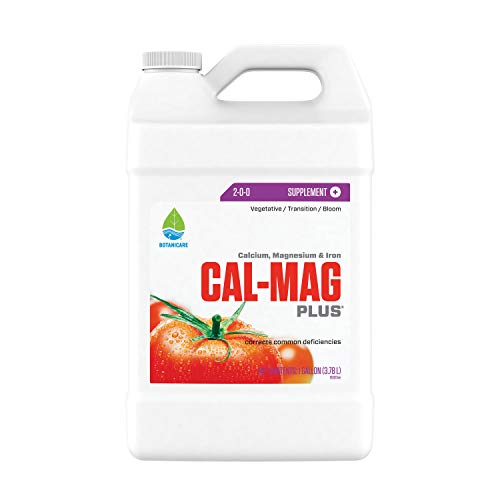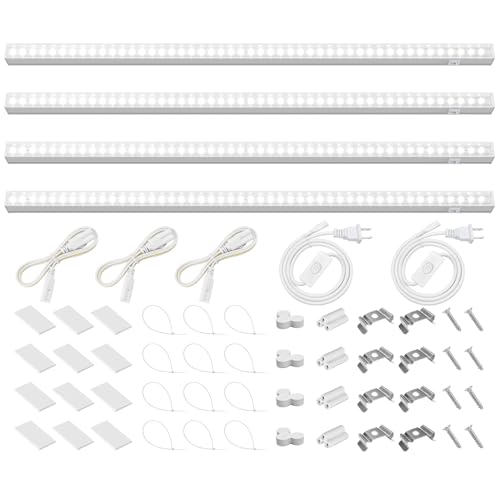Listen here, berry lovers, and let me tell you a secret that changed my life. I spent decades on my knees, battling weeds, praying for sunshine, and crossing my fingers that a late frost wouldn’t decimate my harvest. Then, a little over a decade ago, I discovered the magic of hydroponics. Now, I’m a third-generation berry farmer who grows winter strawberries sweeter than anything I ever pulled from the soil. The secret isn’t a green thumb; it’s a smart system. You’ll be able to pluck ripe, red gems from your indoor garden while the snow flies outside. There’s no dirt, no weeding, just pure, unadulterated berry bliss. I’m here to show you how. We’re going to turn your indoor space into a year-round strawberry patch that produces berries so sweet they’ll make your heart sing.
Note: Some regions restrict home agriculture. Check local ordinances before setup.
Why Soil Can’t Compete with a Hydroponic Strawberry System
Now, don’t get me wrong, I have a deep and abiding respect for good ol’ dirt. But for growing strawberries that truly burst with flavor and size, soil just can’t keep up.
Think of it like this: a plant in soil has to work for everything. Its roots spread out, searching for water and nutrients that may or may not be there. It’s a constant struggle. A hydroponic strawberry plant, on the other hand, lives in luxury. Its roots are bathed in a perfectly balanced, nutrient-rich solution, getting everything they need, exactly when they need it. This coddled existence has a few major payoffs for us growers.
First, let’s talk about yield. When plants don’t have to spend energy hunting for food, they can pour all that effort into producing fruit. In my early days of growing hydroponically, I saw a 3x increase in yield per square foot compared to my traditional soil rows. With vertical towers, that number can climb even higher, giving you more berries from a tiny footprint than a small field. And because we’re not tied to the seasons, we get to do this all year long!
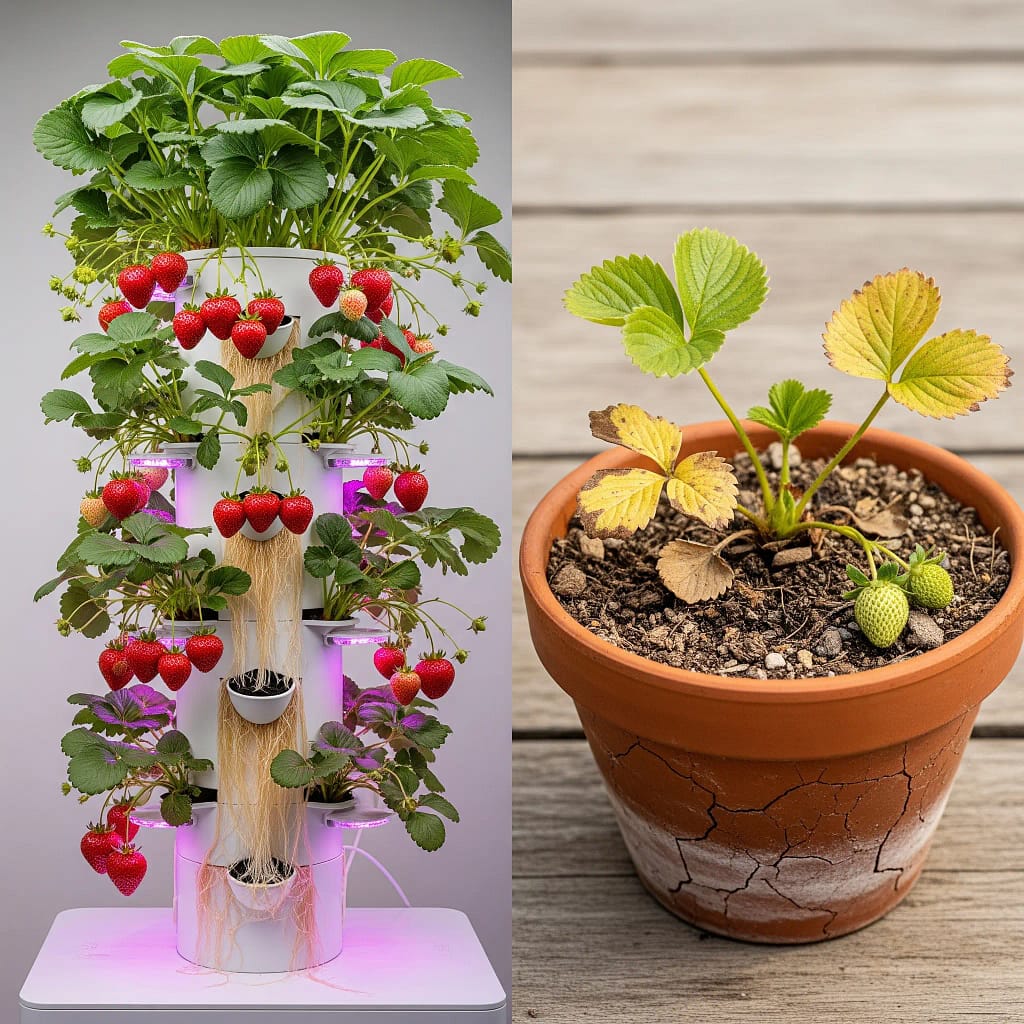
Second, taste. This is the big one. I killed 50 plants learning some of these secrets, but it was worth it. A lot of folks think soil-grown fruit is naturally better. But the truth is, the sweetness, the aroma, and that perfect hint of tartness come from a precise balance of nutrients and light. In my soil days, a dry spell could leave my berries tasting like cardboard, and too much rain would make them watery. With a hydroponic system, you have the power to create the perfect flavor profile, growing fruit that sings with tart-sweet harmony and boasts a Brix level (that’s the sugar content, folks) well above what you’ll find in most store-bought berries. It’s a game-changer.
Bare Root Bootcamp: How to Start with Hydroponic Strawberries
Most commercial and home growers start with bare root strawberry crowns, not seeds. This gives us a massive head start. A bare root plant is essentially a dormant plant that has already developed a crown and a root system. It’s just waiting for the right conditions to wake up.
Grandma’s Secret #1: The Ice Bath. Before you put those bare root crowns anywhere near your hydroponic system, you need to wake them up. I take my dormant crowns and soak them in a bucket of cool, aerated water for a couple of hours. Then, I pop them in a bag in the fridge for a day or two. This tricks them into thinking they’ve just come out of a winter slumber, and they’ll be ready to burst with new life once you plant them.
After their winter nap, it’s time to pot them up. We use rockwool plugs or coconut coir as a growing medium. The medium’s main job is to anchor the plant, not provide nutrients. With your roots cleaned and separated, gently place the crown into your chosen medium, making sure the top of the crown is just at the surface. Don’t bury it! Burying the crown is a surefire way to invite rot and kill the plant before it even starts.
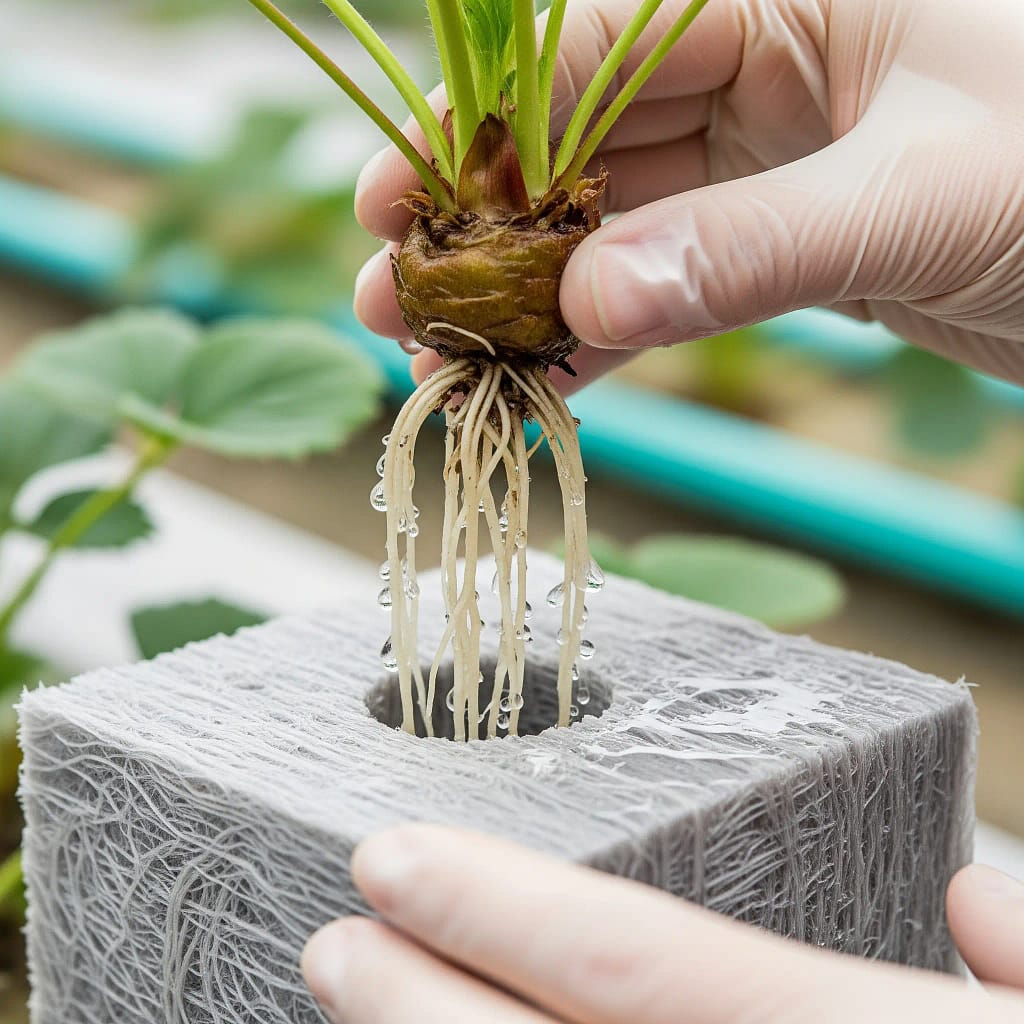
The Perfect Environment Blueprint
This is where the real work—and the real fun—begins. We’re about to become microclimate engineers. Getting this right is the most critical step to producing a bumper crop of sweet, juicy berries.
pH Precision: The 5.5-6.5 Sweet Spot
Think of pH like the key to a treasure chest. The nutrients are the treasure, and if your pH is off, the lock won’t open. The roots simply can’t absorb the nutrients effectively. For strawberries, that perfect key is a slightly acidic pH range of
If your pH climbs above 6.5, essential micronutrients like iron and manganese get “locked out.” You’ll see this as pale, yellowing leaves—a telltale sign of an iron deficiency. Drop below 5.5, and you risk damaging the roots and creating other nutrient imbalances. I check my pH levels every other day. It’s an easy, two-minute job that saves weeks of headaches down the line. Keep a good pH meter and some pH Up/pH Down on hand, and you’ll be golden. For more tips on managing your nutrient solution, check out our in-depth guide to Hydroponic Nutrient Management.
Temperature Magic: Day/Night Tricks
This is where I learned one of my most painful lessons. My first few crops tasted bland, and I couldn’t figure out why. I thought warmer temps meant faster growth and sweeter fruit, but I was dead wrong. I ended up with a bunch of berries that tasted like a bland tomato. The secret is mimicking a natural day/night cycle.
Strawberries need a chilly night to develop their sugars. During the day, keep your temperatures between 15-27°C. At night, let those temperatures drop to a cool 10-12.7°C. This temperature swing is essential for converting starches into sugars, giving your berries that deep, rich sweetness. I lost 50 plants learning this lesson, so trust me on this one. It’s the difference between a good berry and a true flavor bomb.
Humidity Control Hacks
Strawberries are not desert plants. They thrive in a moderately humid environment. Your goal is to maintain a relative humidity (RH) between 60-75%. If the air gets too dry, the plants can get stressed, and spider mites—tiny pests that thrive in low humidity—will come looking for a home5. If it gets too humid, you’re inviting fungal diseases like powdery mildew and Botrytis (gray mold) to set up shop.
Grandma’s Secret #2: The Wet Towel Trick. A simple and budget-friendly hack for boosting humidity in a small grow space is to hang a wet towel or sponge near your plants. You can also run a small humidifier or a fan set to low to keep the air moving and prevent moisture from pooling on the leaves.
Lighting for Luscious Berries: LED vs Sunlight
Every plant needs light to live, and strawberries are no different. They are “long-day” plants, meaning they need a decent amount of light to fruit. Whether you use natural sunlight or artificial lights, you’ll want to provide your plants with 12-16 hours of light per day. For an indoor setup, high-quality full-spectrum LED grow lights are the best choice.
I’ve experimented with both and here’s what I’ve found: LEDs give you total control. You can adjust the intensity and spectrum (the “color” of the light). A higher proportion of blue light is great for vegetative growth (leaves), while red light is key for encouraging flowers and fruit. You can create a perfect sunrise-to-sunset simulation, and your plants will reward you with consistent, high-quality yields. A lot of beginner hydroponic kits come with simple white LED lights, which work just fine, but if you want to geek out and really dial in that flavor, adjustable LEDs are the way to go.
Nutrient Mixology: What to Feed Your Plants
Your nutrient solution is the lifeblood of your strawberry plants. Getting it right is the secret to getting a plant that produces a true flavor bomb. My early attempts at mixing my own concoctions resulted in either nutrient burn or deficiencies, so I highly recommend starting with a premixed, strawberry-specific formula.
When a plant is in its vegetative stage (growing leaves and runners), it needs more Nitrogen (the “N” in NPK). When it’s ready to flower and fruit, it needs more Phosphorus (“P”) and Potassium (“K”). Because strawberries are always in some stage of flowering or fruiting once they’re established, a “bloom” or “fruit” formula is usually best. A good starting point is a formula with a ratio of around
This mix, along with a host of critical micronutrients, will give your plants the power they need to produce beautiful, red berries. The most important thing is to follow the manufacturer’s instructions for mixing and to pay attention to your plants. A plant will tell you if it’s happy. Pay close attention to the EC (electrical conductivity) and pH to make sure they’re in the right zone.
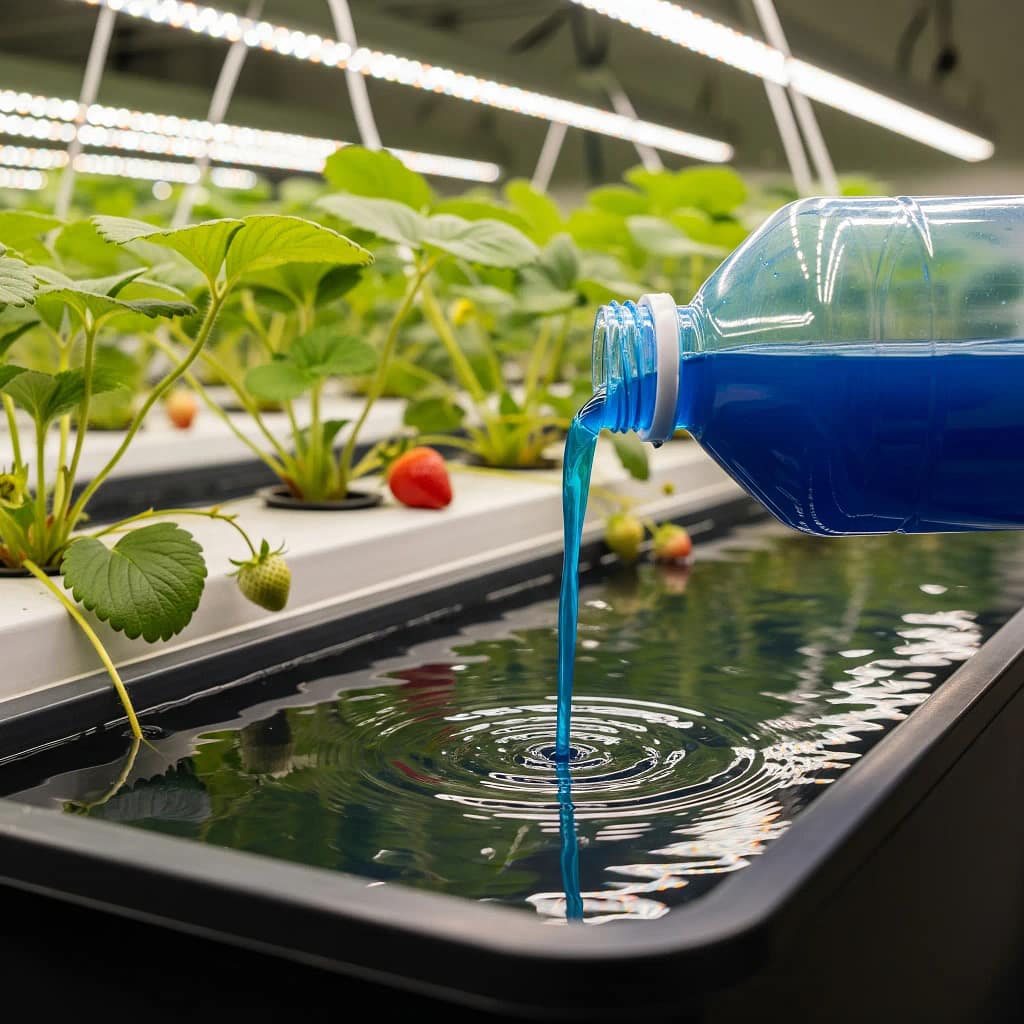
Pollination Party: Bees not required!
One of the big myths of growing indoors is that you can’t pollinate your plants without a hive of bees. Not true! Strawberries are self-pollinating, meaning each flower has both male and female parts. Your job is to simply get the pollen from the male parts to the female parts. This is a crucial step that you’ll need to perform 2-3 times per week, especially when your plants are in full bloom.
Here are a few ways to get the job done:
- The Hand-Brush Method: This is the most gentle and precise method. Use a small, soft-bristled artist’s brush. Gently swirl the brush inside each open flower to collect and distribute the pollen.
- The Electric Toothbrush Method: This is my favorite low-tech hack. Take a new, unused electric toothbrush and gently press the vibrating tip against the base of each flower for a few seconds. The vibrations shake the pollen loose and send it on its way.
I’ve used both of these methods with great success. The goal is simply to help nature along. You’ll know it worked when the center of the flower starts to swell and turn into a tiny green berry.
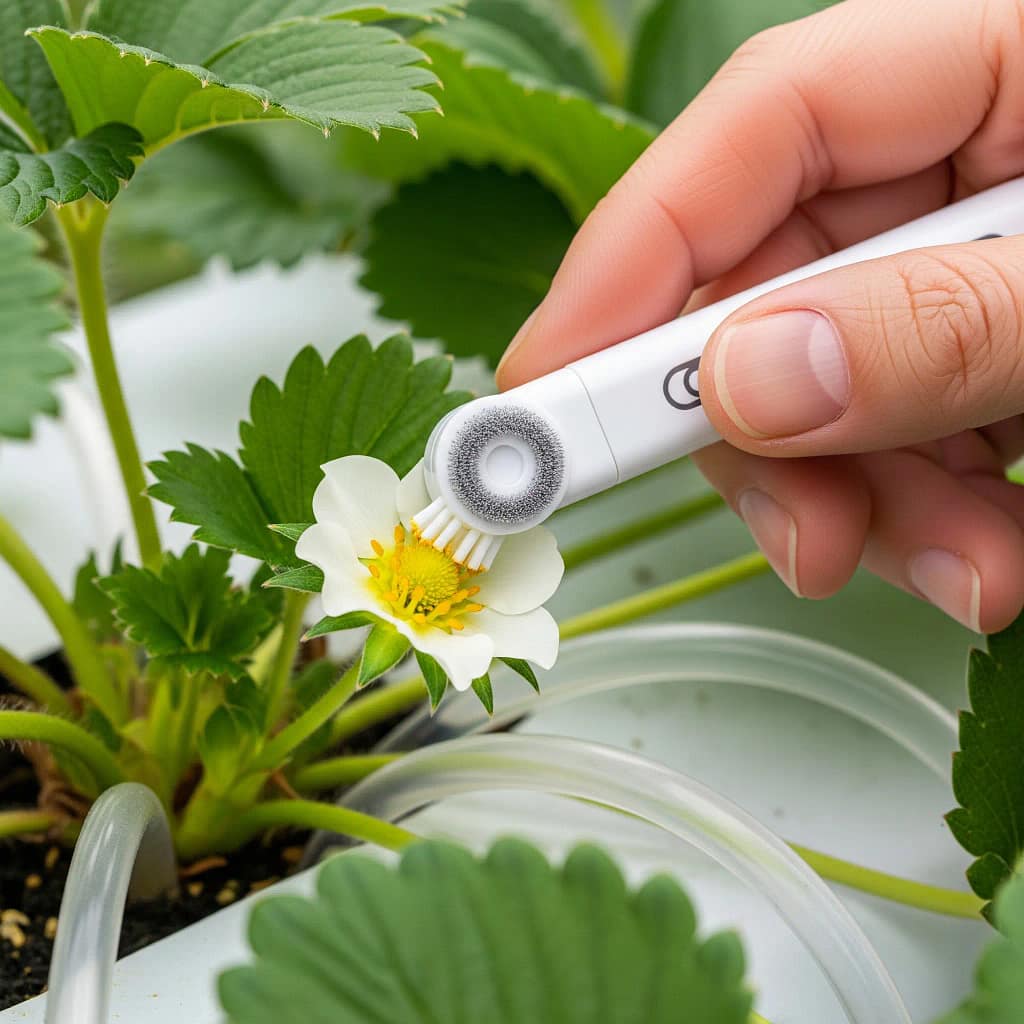
Pruning for Profit: Managing Runners
If you’ve ever grown strawberries in soil, you know they send out runners everywhere, trying to take over the world. In a hydroponic system, runners are a bad habit that we need to break. These long, vine-like growths are a plant’s way of cloning itself, but they steal energy that should be going into making berries. Your goal is to prune these runners back as soon as you see them. You’re trying to tell the mother plant: “Focus on making big, juicy berries, not on making baby plants!”
You should also snip off any yellowing or dead leaves. This helps prevent disease and ensures the plant’s energy is directed where it matters most: into the fruit. Just be careful not to snip any new flower buds. It might feel a little harsh at first, but your harvest will thank you.
The Berry Baron’s Flavor Bomb Checklist
| Factor | Poor Flavor Range | Optimal Range |
| Night Temp | >15°C | 10-12.7°C |
| Brix Level | <8° | 12-14° |
| Harvest Time | Afternoon | Morning |
Berry Grower’s Toolkit: My Go-To Gear
I’ve spent years tinkering with different tools, and I’ve learned that the right equipment can make all the difference. These are the workhorses I rely on to get a year-round supply of sweet, delicious berries. All of these products are ones I’ve personally used and recommend.
VIVOSUN 5-Pack 5-Gallon Grow Bags
Durable, fabric grow bags perfect for a simple, substrate-based drip system for strawberries, providing excellent aeration and preventing root rot.
- Premium Construction: It’s made of thickened nonwoven fabric and has reinforced sturdy handle straps for easier, secure …
- Built-in Metal Rings: Low-stress training can be easily applied by threading string through the metal rings; This techni…
- Breathable: The nonwoven fabric ensures that your plant roots stay aerated and are air-pruned inside the grow bag, which…
Why Growers Love It:
- Superior Aeration: Fabric design allows air pruning for healthier, denser root systems, critical for strawberry health.
- Space-Efficient: Perfect for compact spaces and patio gardens; can be arranged flexibly.
- Durable Material: Reinforced handles and thick, non-woven fabric last multiple seasons.
Room for Improvement:
- Water Drainage: Can dry out faster than plastic pots in warm climates, requiring more frequent watering checks.
- Stability: Lightweight; may tip over with top-heavy plants if not supported.
Bottom Line for Growers: The simplest, most foolproof way to start a substrate-based strawberry garden. Pair with a simple drip system for best results. Check Price on Amazon.
General Hydroponics Flora Series Performance Pack
The iconic 3-part nutrient system with CALiMAGic and RapidStart supplements.
- The Flora Series is a hydroponic-based nutrient system that helps fulfill your plants’ nutrient needs at every stage of …
- Nutrients included in the Series are FloraMicro, FloraBloom, and FloraGro
- FloraMicro: contains nitrogen and calcium, as well as trace minerals, which are essential for a comprehensive hydroponic…
Why Growers Love It:
- Complete Nutrition: Three-part system provides precise control over each growth phase
- pH Stability: Buffered formulation minimizes pH drift in reservoir
- Strain Specific: Feeding charts available for various cannabis genetics
Room for Improvement:
- Mixing Order: Requires specific mixing sequence to prevent nutrient lockout
- Supplement Needs: May require additional PK boosters for heavy-feeding strains
Bottom Line for Growers: The industry standard for reliability. Perfect for growers who want predictable results harvest after harvest. Check Price on Amazon.
Botanicare Cal-Mag Plus, 1-Gallon
A concentrated calcium, magnesium, and iron supplement designed to prevent and correct nutrient deficiencies in hydroponic cannabis systems.
- Highly fortified calcium, magnesium, and iron plant supplement formulated to correct common deficiencies
- Supplement your existing nutrient program with Cal-Mag Plus
- To Use: Mix well and use with every watering, as needed, for enhanced growth apply as a foliar spray
Why Growers Love It:
- Defense Against Deficiencies: Specifically formulated to prevent and correct calcium and magnesium deficiencies, which are common in hydroponic cannabis grows and manifest as rusty spots and crispy leaf tips .
- Enhanced Absorption: The chelated form of nutrients ensures optimal uptake by plants, even in fluctuating pH conditions .
- Versatile Use: Can be used in both hydroponic and soil-based systems, and is compatible with most nutrient lines .
Room for Improvement:
- Concentrated Formula: Requires careful measurement to avoid overuse, which can lead to nutrient lockout .
- Price Point: Higher cost per ounce compared to some generic Cal-Mag supplements, but the quality justifies the price .
Bottom Line for Growers: An essential insurance policy for hydroponic cannabis growers. I use it with every feeding to prevent the common deficiencies that plague so many gardens
Govee WiFi Hygrometer Thermometer 3-Pack
Wireless sensors that monitor temperature/humidity 24/7 and sync data to a smartphone app for export.
- Smart WiFi Temperature Sensor: With the 3 included sensors, you can easily monitor temperature and humidity data in real…
- Versatile and Accurate: Swiss-made sensors provide a wide range for detecting humidity and temperature. The range for te…
- Alert Function: Set preset temperature and humidity ranges, and the Govee APP will alert you via cell phone when the sma…
Bloom & Boost:
- Automated Data Logging: Graphs trends in real-time, eliminating manual humidity/temp recordings.
- Multi-Sensor Support: Place units across tents to map microclimates and hotspot risks.
- Custom Alerts: Notifications for VPD outliers prevent mold or heat stress.
The Trade-Off:
- Battery Dependency: Requires AAA battery replacements every 4-6 months.
- No EC/pH Tracking: Limited to environmental metrics only.
Who This Is For: Growers automating climate logs. Pair with pH pens to cross-reference environmental and nutrient data. See Latest Discount.
HIRALIY 50ft Drip Irrigation Kit
A complete DIY drip system kit with timers, filters, and emitters, ideal for automating watering for container-grown strawberries.
- Adjustable Water Flow: The drip emitter can be adjusted to stop, micro-drip, and spray so that you can use the water dri…
- No-leaking Brass Splitter: The splitter has a solid brass construction and no rust. It not only separates the two drip l…
- Easy To Assemble and Use: Simple installation, simply insert the fittings and droppers, and you can begin watering your …
Grow Room Win:
- Complete Automation: Includes a digital timer to schedule precise watering cycles, ensuring consistent moisture.
- Customizable Layout: 50 feet of tubing and various emitters let you design a system for any number of plants.
- Water Filter: Built-in filter prevents emitters from clogging with sediment or nutrient particles.
The Trade-Off:
- Water Pressure: Requires adequate water pressure; may struggle with very low-pressure sources.
- Assembly: Requires time to assemble and customize for your specific garden layout.
The Final Verdict: The easiest way to upgrade from hand-watering. Takes the guesswork and daily chore out of watering your strawberry patch. Check Price on Amazon.
Barrina LED Grow Lights 2FT, 4-Pack
Full-spectrum T5 LED lights perfect for supplementing natural light for strawberries on shelves or in a greenhouse.
- 5000K Full Spectrum: Barrina T5 grow lights, offer the most reasonable grow light wavelengths based on the ratio of plan…
- High PPFD: This grow light strip with high PPFD maximize photosynthesis efficiency and promote rapid, healthy plant grow…
- 3-in-1 Installation: With included double-sided tape, clips and cable ties, you could easily install the led plant light…
The Green Thumb Upside:
- Full Spectrum: Provides the blue and red light spectra strawberries need for growth and flowering.
- Easy Installation: Daisy-chain design and included hanging kits make setup simple.
- Energy Efficient: Low profile and low heat output allow them to be placed close to plants.
Grower’s Notes:
- Coverage: This 4-pack is ideal for a single 2-ft x 4-ft shelf; larger areas need more lights.
- Intensity: Best for supplemental lighting; primary lighting for a large crop requires more powerful fixtures.
The Seedling Lowdown: The perfect, cost-effective solution for starting seedlings or boosting light for a small strawberry patch indoors or in a garage. See Latest Discount on Amazon.
Key Considerations for Your Strawberry Garden:
- Start with Runners: For a faster harvest, begin with strawberry “plugs” or “runners” rather than seeds.
- Variety Matters: Choose day-neutral or everbearing varieties like ‘Albion’ or ‘Seascape’ for a continuous harvest all season long.
- Pollination: Gently shake flower clusters or use a small brush to aid pollination if growing indoors without bees.
- Cleanliness: Remove old or yellowing leaves regularly to improve air circulation and prevent disease.
Note: Product availability and prices may change. Verify specs on Amazon before purchase. We participate in the Amazon Services LLC Associates Program.
Conclusion
I hope this guide has shown you that growing strawberries indoors is not just possible, but incredibly rewarding. By providing the right foundation—the perfect pH and temperature, a balanced nutrient solution, and plenty of light—you can grow berries so good they’ll make you wonder why anyone bothers with a field. The key is in the details, but once you get the hang of it, the process becomes second nature. And let me tell you, there’s nothing quite like plucking a ruby-red berry from your own hydroponic garden in the dead of winter. Now, go on and grow something delicious. For more in-depth guides and tips on perfecting your indoor farm, head over to our other articles at MistCulture.com.

